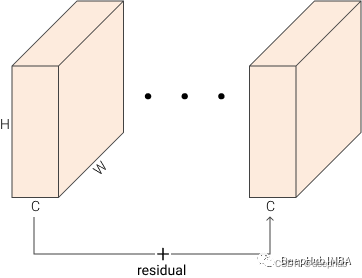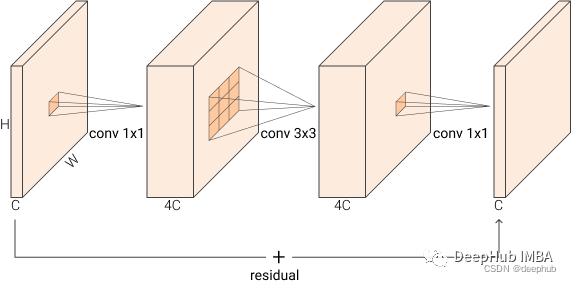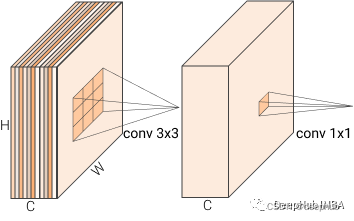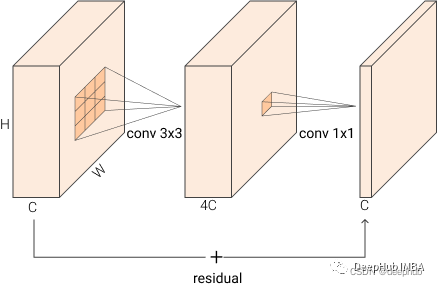上篇ConvNext的文章有小伙伴问BottleNeck,Inverted Residual的区别,所以找了这篇文章,详细的解释一些用到的卷积块,当作趁热打铁吧
在介绍上面的这些概念之间,我们先创建一个通用的 conv-norm-act 层,这也是最基本的卷积块。
fromfunctoolsimportpartial
fromtorchimportnn
classConvNormAct(nn.Sequential):
def__init__(
self,
in_features: int,
out_features: int,
kernel_size: int,
norm: nn.Module = nn.BatchNorm2d,
act: nn.Module = nn.ReLU,
**kwargs
):
super().__init__(
nn.Conv2d(
in_features,
out_features,
kernel_size=kernel_size,
padding=kernel_size//2,
),
norm(out_features),
act(),
)
Conv1X1BnReLU = partial(ConvNormAct, kernel_size=1)
Conv3X3BnReLU = partial(ConvNormAct, kernel_size=3)
importtorch
x = torch.randn((1, 32, 56, 56))
Conv1X1BnReLU(32, 64)(x).shape
#torch.Size([1, 64, 56, 56])
残差连接
ResNet 中提出并使用了残差连接, 这个想法是将层的输入与层的输出相加,输出 = 层(输入)+ 输入。下图可以帮助您将其可视化。但是,它只使用了一个 + 运算符。残差操作提高了梯度在乘法器层上传播的能力,允许有效地训练超过一百层的网络。

在PyTorch中,我们可以轻松地创建一个ResidualAdd层
fromtorchimportnn
fromtorchimportTensor
classResidualAdd(nn.Module):
def__init__(self, block: nn.Module):
super().__init__()
self.block = block
defforward(self, x: Tensor) ->Tensor:
res = x
x = self.block(x)
x += res
returnx
ResidualAdd(
nn.Conv2d(32, 32, kernel_size=1)
)(x).shape
捷径 Shortcut
有时候残差没有相同的输出维度,所以无法将它们相加。所以就需要使用conv(带+的黑色箭头)来投影输入,以匹配输出的特性
fromtypingimportOptional
classResidualAdd(nn.Module):
def__init__(self, block: nn.Module, shortcut: Optional[nn.Module] = None):
super().__init__()
self.block = block
self.shortcut = shortcut
defforward(self, x: Tensor) ->Tensor:
res = x
x = self.block(x)
ifself.shortcut:
res = self.shortcut(res)
x += res
returnx
ResidualAdd(
nn.Conv2d(32, 64, kernel_size=1),
shortcut=nn.Conv2d(32, 64, kernel_size=1)
)(x).shape
瓶颈块 BottleNeck
在用于图像识别的深度残差网络中也引入了瓶颈块。BottleNeck 块接受大小为 BxCxHxW 的输入,它首先使用1x1 卷积将其缩减为 BxC/rxHxW,然后再应用 3x3 卷积,最后再使用 1x1 卷积将输出重新映射到与输入相同的特征维度BxCxHxW 。这比使用三个 3x3 转换要快的多,由于中间层减少输入维度,所以将其称之为“BottleNeck”。下图可视化了该块,我们在原始实现中使用 r=4

前两个convs之后是batchnorm和一个非线性激活,在加法之后还有一个非线性的激活
fromtorchimportnn
classBottleNeck(nn.Sequential):
def__init__(self, in_features: int, out_features: int, reduction: int = 4):
reduced_features = out_features//reduction
super().__init__(
nn.Sequential(
ResidualAdd(
nn.Sequential(
# wide -> narrow
Conv1X1BnReLU(in_features, reduced_features),
# narrow -> narrow
Conv3X3BnReLU(reduced_features, reduced_features),
# narrow -> wide
Conv1X1BnReLU(reduced_features, out_features, act=nn.Identity),
),
shortcut=Conv1X1BnReLU(in_features, out_features)
ifin_features!= out_features
elseNone,
),
nn.ReLU(),
)
)
BottleNeck(32, 64)(x).shape
请注意这里仅在输入和输出特征维度不同时才使用shortcut。
一般情况下当希望减少空间维度时,在中间卷积中使用 stride=2。
线性瓶颈 Linear BottleNeck
线性瓶颈是在 MobileNetV2: Inverted Residuals 中引入的。线性瓶颈块是不包含最后一个激活的瓶颈块。在论文的第 3.2 节中,他们详细介绍了为什么在输出之前存在非线性会损害性能。简而言之:非线性函数 Line ReLU 将所有 < 0 设置为 0会破坏信息。根据经验表明,当输入的通道小于输出的通道时删除最后的激活函数是正确的。所以只要删除 BottleNeck 中的 nn.ReLU 即可。
倒置残差 Inverted Residual
在 MobileNetV2 中还引入了倒置残差。Inverted Residual 块是倒置的 BottleNeck 层。他们使用第一个 conv 对维度进行扩展而不是减少。下图应该清楚地说明这一点

从 BxCxHxW -> BxCexHxW -> BxCexHxW -> BxCxHxW,其中 e 是膨胀比,默认设置为 4。而不是像正常的瓶颈块那样变宽 -> 窄 -> 宽,他们做相反的事情 窄 -> 宽 -> 窄。
classInvertedResidual(nn.Sequential):
def__init__(self, in_features: int, out_features: int, expansion: int = 4):
expanded_features = in_features*expansion
super().__init__(
nn.Sequential(
ResidualAdd(
nn.Sequential(
# narrow -> wide
Conv1X1BnReLU(in_features, expanded_features),
# wide -> wide
Conv3X3BnReLU(expanded_features, expanded_features),
# wide -> narrow
Conv1X1BnReLU(expanded_features, out_features, act=nn.Identity),
),
shortcut=Conv1X1BnReLU(in_features, out_features)
ifin_features!= out_features
elseNone,
),
nn.ReLU(),
)
)
InvertedResidual(32, 64)(x).shape
在 MobileNet 中,残差连接仅在输入和输出特征匹配时应用,这个我们在前面已经说明了
classMobileNetLikeBlock(nn.Sequential):
def__init__(self, in_features: int, out_features: int, expansion: int = 4):
# use ResidualAdd if features match, otherwise a normal Sequential
residual = ResidualAddifin_features == out_featureselsenn.Sequential
expanded_features = in_features*expansion
super().__init__(
nn.Sequential(
residual(
nn.Sequential(
# narrow -> wide
Conv1X1BnReLU(in_features, expanded_features),
# wide -> wide
Conv3X3BnReLU(expanded_features, expanded_features),
# wide -> narrow
Conv1X1BnReLU(expanded_features, out_features, act=nn.Identity),
),
),
nn.ReLU(),
)
)
MobileNetLikeBlock(32, 64)(x).shape
MobileNetLikeBlock(32, 32)(x).shape
MBConv
在 MobileNetV2 之后,它的构建块被称为 MBConv。MBConv 是具有深度可分离卷积的倒置线性瓶颈层,听着很绕对吧,其实就是把上面我们介绍的几个块进行了整合。
1、深度可分离卷积 Depth-Wise Separable Convolutions
Depth-Wise Separable Convolutions 是一种减少参数的数量技巧,它将一个普通的 3x3 卷积拆分为两个卷积。第一个卷积将单个的 3x3 卷积核应用于每个输入的通道,另一个卷积将 1x1 卷积核应用于所有通道。这和做一个普通的 3x3 转换是一样的,但是却减少了参数。
但是其实这个有点多余,因为在我们现有的硬件上它比普通的 3x3 慢得多。

通道中的不同颜色代表每个通道应用的一个单独的卷积核(过滤器)
classDepthWiseSeparableConv(nn.Sequential):
def__init__(self, in_features: int, out_features: int):
super().__init__(
nn.Conv2d(in_features, in_features, kernel_size=3, groups=in_features),
nn.Conv2d(in_features, out_features, kernel_size=1)
)
DepthWiseSeparableConv(32, 64)(x).shape
让我们看看参数减少了多少:
sum(p.numel() forpinDepthWiseSeparableConv(32, 64).parameters() ifp.requires_grad)
#2432
再看看一个普通的 Conv2d
sum(p.numel() forpinnn.Conv2d(32, 64, kernel_size=3).parameters() ifp.requires_grad)
#18496
这是巨大的差距
2、完成MBConv
现在可以创建一个完整的 MBConv。MBConv 有几个重要细节,归一化适用于深度和点卷积,非线性仅适用于深度卷积(请记住线性瓶颈)。而激活函数使用ReLU6 。我们现在把把所有东西放在一起
classMBConv(nn.Sequential):
def__init__(self, in_features: int, out_features: int, expansion: int = 4):
residual = ResidualAddifin_features == out_featureselsenn.Sequential
expanded_features = in_features*expansion
super().__init__(
nn.Sequential(
residual(
nn.Sequential(
# narrow -> wide
Conv1X1BnReLU(in_features,
expanded_features,
act=nn.ReLU6
),
# wide -> wide
Conv3X3BnReLU(expanded_features,
expanded_features,
groups=expanded_features,
act=nn.ReLU6
),
# here you can apply SE
# wide -> narrow
Conv1X1BnReLU(expanded_features, out_features, act=nn.Identity),
),
),
nn.ReLU(),
)
)
MBConv(32, 64)(x).shape
在 EfficientNet 中也使用的是带有 Squeeze 和 Excitation的这个块的修改的版本。
融合倒置残差 (Fused MBConv)
在 EfficientNetV2: Smaller Models and Faster Training 中引入了 Fused Inverted Residuals,这样可以使 MBConv 更快。解决了我们上面说的深度卷积很慢的问题,它们将第一个和第二个卷积融合在一个 3x3 卷积中(第 3.2 节)。

classFusedMBConv(nn.Sequential):
def__init__(self, in_features: int, out_features: int, expansion: int = 4):
residual = ResidualAddifin_features == out_featureselsenn.Sequential
expanded_features = in_features*expansion
super().__init__(
nn.Sequential(
residual(
nn.Sequential(
Conv3X3BnReLU(in_features,
expanded_features,
act=nn.ReLU6
),
# here you can apply SE
# wide -> narrow
Conv1X1BnReLU(expanded_features, out_features, act=nn.Identity),
),
),
nn.ReLU(),
)
)
MBConv(32, 64)(x).shape
总结
本文介绍了这些基本的卷积块的操作和代码, 这些卷积块的架构是我们在CV中经常会遇到的,所以强烈建议阅读与他们相关的论文。另外如果你对本文代码感兴趣,请看这里:
https://avoid.overfit.cn/post/af49b27f50bb416ca829b4987e902874
作者:Francesco Zuppichini
